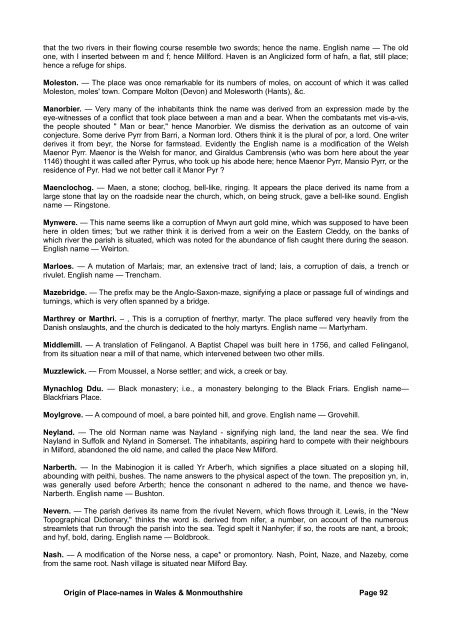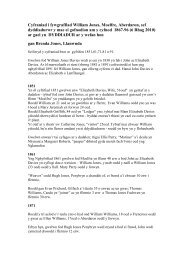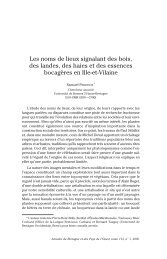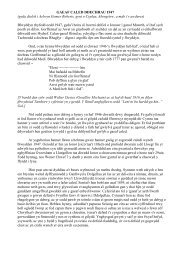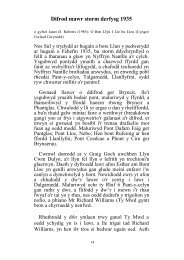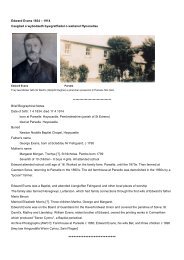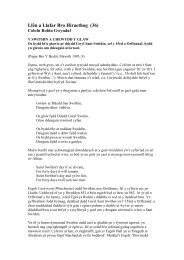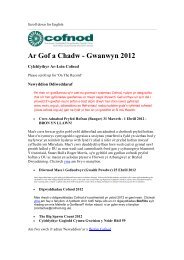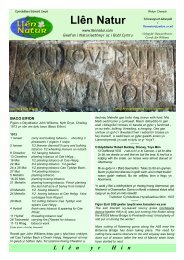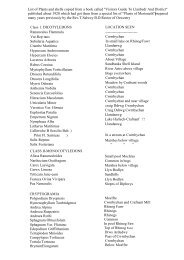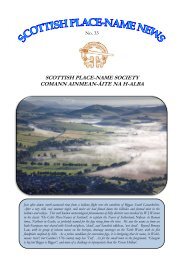Keswick. -.(Cumberl<strong>and</strong>), Cissa's dwell<strong>in</strong>g.Lawrenny. — Some th<strong>in</strong>k it is a corruption <strong>of</strong> llawreni, plural <strong>of</strong> llawren, or llawr, floor, ground. O<strong>the</strong>rs th<strong>in</strong>k itis a corruption <strong>of</strong> Llan-yr-ynys, a church <strong>in</strong> <strong>the</strong> isl<strong>and</strong>. This accords with <strong>the</strong> topographical situation <strong>of</strong> <strong>the</strong><strong>place</strong>, as it is an isl<strong>and</strong> surrounded by water, form<strong>in</strong>g two creeks, one runn<strong>in</strong>g to Carew <strong>and</strong> <strong>the</strong> o<strong>the</strong>r toLangum. We prefer <strong>the</strong> follow<strong>in</strong>g: Llawr, ground; yn, <strong>the</strong>; wy, water; signify<strong>in</strong>g l<strong>and</strong> <strong>in</strong> <strong>the</strong> water, an isl<strong>and</strong>.English name — Islet.Langum. — A corruption <strong>of</strong> Llangwm, signify<strong>in</strong>g a church <strong>in</strong> <strong>the</strong> valley. English name— Church vale.Ludchurch. — The Welsh name is Eglwys Lwyd. Lud is an Anglicism <strong>of</strong> lwyd~llwyd, adorable, blessed.English name — Holychurch.Lambstone. — So called <strong>in</strong> honour <strong>of</strong> Lambi or Lamba, one <strong>of</strong> <strong>the</strong> settlers <strong>of</strong> <strong>the</strong> Welsh colony, whose nameis also preserved <strong>in</strong> Lambeth, Lambourne, <strong>and</strong> <strong>in</strong> <strong>the</strong> surname Lambe.Lamphey. — A corruption <strong>of</strong> Llanyffydd, Fanum Fidei, <strong>the</strong> church <strong>of</strong> <strong>the</strong> faith. It is spelt <strong>in</strong> some olddocuments Llanfaith <strong>and</strong> Llanfeth; <strong>the</strong>n it was corrupted <strong>in</strong>to Llanfey <strong>and</strong> Lamphey. The consonant n isfrequently substituted <strong>in</strong> Welsh <strong>place</strong>-<strong>names</strong> <strong>in</strong> lieu <strong>of</strong> <strong>the</strong> letter m. English name — Faithchurch.Lanteague. — Probably a corruption <strong>of</strong> Llan-deg* signify<strong>in</strong>g a fair church. English name — Fairchurch.Letterston. — A translation <strong>of</strong> <strong>the</strong> Welsh name, Trelettert, from Lettard, <strong>the</strong> ancient owner <strong>of</strong> <strong>the</strong> l<strong>and</strong>, whogave <strong>the</strong> advowson <strong>of</strong> <strong>the</strong> church, with <strong>the</strong> chapel <strong>of</strong> LIanfair annexed, to <strong>the</strong> comm<strong>and</strong>ery <strong>of</strong> Slebech.Llaniaden. -- Lladen is a corruption <strong>of</strong> Aeddan, <strong>the</strong> name <strong>of</strong> <strong>the</strong> patron sa<strong>in</strong>t <strong>of</strong> <strong>the</strong> parish church. Pr<strong>of</strong>essorRhys refers <strong>the</strong> name Aedd to <strong>the</strong> word udd, which is expla<strong>in</strong>ed <strong>in</strong> Dr. Davis's dictionary as mean<strong>in</strong>gdom<strong>in</strong>us, master. " It would seem," he says, " to be matched <strong>in</strong> O. Irish by Oeda, <strong>the</strong> genitive <strong>of</strong> Oed, laterAedh, Aodh y Haodli, Anglicized Hugh, <strong>and</strong> <strong>the</strong> late Mr. Stephens, <strong>of</strong> Merthyr Tydfil, was probably right <strong>in</strong>regard<strong>in</strong>g <strong>the</strong> Aedd <strong>of</strong> modern Welsh tradition as a Goidelic importation from North Brita<strong>in</strong>." English name —Masterchurch.Llanfrynach or Llanfyrnach. — From Brynach, a popular Irish sa<strong>in</strong>t, who accompanied BrychanBrycheimog to Brita<strong>in</strong> <strong>in</strong> <strong>the</strong> fifth century. English name — Waterhill.Llangl<strong>of</strong>fan. — The church is dedicated to Cl<strong>of</strong>fan. English name — Cl<strong>of</strong>fan.Llangolman.--.From Coltnan, supposed to be an Irish sa<strong>in</strong>t. English name — Colman.Llanwnda. — Wnda is a corruption <strong>of</strong> Gwyndaf, a descendant <strong>of</strong> Emyr Llydaw, <strong>and</strong> a sa<strong>in</strong>t <strong>of</strong> <strong>the</strong> sixthcentury, who is supposed to have been <strong>the</strong> founder <strong>of</strong> <strong>the</strong> church. Llanwnda Po<strong>in</strong>t is celebrated for <strong>the</strong>surrender, <strong>in</strong> 1797, <strong>of</strong> <strong>the</strong> French troops under General Tate. English name — Fairby.Llantyd. — Tyd is an abbreviation <strong>of</strong> Illtyd, to whom <strong>the</strong> church is dedicated. It is also called Llantwd. Englishname — Iltutus.Ll<strong>and</strong>eloy. — A corruption <strong>of</strong> Ll<strong>and</strong>eilo; <strong>the</strong> parish church is dedicated to Teilo. English name — Teilo.Llanrhian. — Rhian is supposed to have been <strong>the</strong> founder <strong>of</strong> <strong>the</strong> church. English name — Ladychurch.Llanst<strong>in</strong>an. — St<strong>in</strong>an or Just<strong>in</strong>ian, a sa<strong>in</strong>t <strong>of</strong> <strong>the</strong> sixth century, was <strong>the</strong> founder <strong>of</strong> <strong>the</strong> church. English name— Just<strong>in</strong>ian.Milford Haven. — Some are <strong>of</strong> op<strong>in</strong>ion that this is a translation <strong>of</strong> Rhyd-y-milwr, <strong>the</strong> name <strong>of</strong> a brook; tak<strong>in</strong>gmil from milwr, a soldier, <strong>and</strong> translat<strong>in</strong>g rhyd <strong>in</strong>to ford, <strong>the</strong>n Milford. O<strong>the</strong>rs th<strong>in</strong>k it is an Anglicized form <strong>of</strong>Myl fdr, or ymyl mdr, border<strong>in</strong>g <strong>the</strong> sea. With<strong>in</strong> a mile <strong>of</strong> <strong>the</strong> present town a streamlet was wont to turn a millthat belonged to <strong>the</strong> Priory, <strong>and</strong>, before <strong>the</strong> bridge-period had dawned <strong>in</strong> <strong>the</strong> district, <strong>the</strong> people were obligedto cross <strong>the</strong> brook over <strong>the</strong> mill's ford, called <strong>in</strong> Welsh Rhydyfel<strong>in</strong>, <strong>and</strong> we <strong>in</strong>cl<strong>in</strong>e to th<strong>in</strong>k Milford is atranslation <strong>of</strong> Rhydyfel<strong>in</strong>. The Welsh name is Aber-dau-gleddyf, from <strong>the</strong> fact that <strong>the</strong> two rivers, CleddauFawr <strong>and</strong> Cleddau Fach, discharge <strong>the</strong>mselves <strong>in</strong>to <strong>the</strong> haven. Dan Gleddyf means two swords. It appearsOrig<strong>in</strong> <strong>of</strong> Place-<strong>names</strong> <strong>in</strong> Wales & Monmouthshire Page 91
that <strong>the</strong> two rivers <strong>in</strong> <strong>the</strong>ir flow<strong>in</strong>g course resemble two swords; hence <strong>the</strong> name. English name — The oldone, with I <strong>in</strong>serted between m <strong>and</strong> f; hence Millford. Haven is an Anglicized form <strong>of</strong> hafn, a flat, still <strong>place</strong>;hence a refuge for ships.Moleston. — The <strong>place</strong> was once remarkable for its numbers <strong>of</strong> moles, on account <strong>of</strong> which it was calledMoleston, moles' town. Compare Molton (Devon) <strong>and</strong> Molesworth (Hants), &c.Manorbier. — Very many <strong>of</strong> <strong>the</strong> <strong>in</strong>habitants th<strong>in</strong>k <strong>the</strong> name was derived from an expression made by <strong>the</strong>eye-witnesses <strong>of</strong> a conflict that took <strong>place</strong> between a man <strong>and</strong> a bear. When <strong>the</strong> combatants met vis-a-vis,<strong>the</strong> people shouted " Man or bear," hence Manorbier. We dismiss <strong>the</strong> derivation as an outcome <strong>of</strong> va<strong>in</strong>conjecture. Some derive Pyrr from Barri, a Norman lord. O<strong>the</strong>rs th<strong>in</strong>k it is <strong>the</strong> plural <strong>of</strong> por, a lord. One writerderives it from beyr, <strong>the</strong> Norse for farmstead. Evidently <strong>the</strong> English name is a modification <strong>of</strong> <strong>the</strong> WelshMaenor Pyrr. Maenor is <strong>the</strong> Welsh for manor, <strong>and</strong> Giraldus Cambrensis (who was born here about <strong>the</strong> year1146) thought it was called after Pyrrus, who took up his abode here; hence Maenor Pyrr, Mansio Pyrr, or <strong>the</strong>residence <strong>of</strong> Pyr. Had we not better call it Manor Pyr ?Maenclochog. — Maen, a stone; clochog, bell-like, r<strong>in</strong>g<strong>in</strong>g. It appears <strong>the</strong> <strong>place</strong> derived its name from alarge stone that lay on <strong>the</strong> roadside near <strong>the</strong> church, which, on be<strong>in</strong>g struck, gave a bell-like sound. Englishname — R<strong>in</strong>gstone.Mynwere. — This name seems like a corruption <strong>of</strong> Mwyn aurt gold m<strong>in</strong>e, which was supposed to have beenhere <strong>in</strong> olden times; 'but we ra<strong>the</strong>r th<strong>in</strong>k it is derived from a weir on <strong>the</strong> Eastern Cleddy, on <strong>the</strong> banks <strong>of</strong>which river <strong>the</strong> parish is situated, which was noted for <strong>the</strong> abundance <strong>of</strong> fish caught <strong>the</strong>re dur<strong>in</strong>g <strong>the</strong> season.English name — Weirton.Marloes. — A mutation <strong>of</strong> Marlais; mar, an extensive tract <strong>of</strong> l<strong>and</strong>; lais, a corruption <strong>of</strong> dais, a trench orrivulet. English name — Trencham.Mazebridge. — The prefix may be <strong>the</strong> Anglo-Saxon-maze, signify<strong>in</strong>g a <strong>place</strong> or passage full <strong>of</strong> w<strong>in</strong>d<strong>in</strong>gs <strong>and</strong>turn<strong>in</strong>gs, which is very <strong>of</strong>ten spanned by a bridge.Marthrey or Marthri. – , This is a corruption <strong>of</strong> fnerthyr, martyr. The <strong>place</strong> suffered very heavily from <strong>the</strong>Danish onslaughts, <strong>and</strong> <strong>the</strong> church is dedicated to <strong>the</strong> holy martyrs. English name — Martyrham.Middlemill. — A translation <strong>of</strong> Fel<strong>in</strong>ganol. A Baptist Chapel was built here <strong>in</strong> 1756, <strong>and</strong> called Fel<strong>in</strong>ganol,from its situation near a mill <strong>of</strong> that name, which <strong>in</strong>tervened between two o<strong>the</strong>r mills.Muzzlewick. — From Moussel, a Norse settler; <strong>and</strong> wick, a creek or bay.Mynachlog Ddu. — Black monastery; i.e., a monastery belong<strong>in</strong>g to <strong>the</strong> Black Friars. English name—Blackfriars Place.Moylgrove. — A compound <strong>of</strong> moel, a bare po<strong>in</strong>ted hill, <strong>and</strong> grove. English name — Grovehill.Neyl<strong>and</strong>. — The old Norman name was Nayl<strong>and</strong> - signify<strong>in</strong>g nigh l<strong>and</strong>, <strong>the</strong> l<strong>and</strong> near <strong>the</strong> sea. We f<strong>in</strong>dNayl<strong>and</strong> <strong>in</strong> Suffolk <strong>and</strong> Nyl<strong>and</strong> <strong>in</strong> Somerset. The <strong>in</strong>habitants, aspir<strong>in</strong>g hard to compete with <strong>the</strong>ir neighbours<strong>in</strong> Milford, ab<strong>and</strong>oned <strong>the</strong> old name, <strong>and</strong> called <strong>the</strong> <strong>place</strong> New Milford.Narberth. — In <strong>the</strong> Mab<strong>in</strong>ogion it is called Yr Arber'h, which signifies a <strong>place</strong> situated on a slop<strong>in</strong>g hill,abound<strong>in</strong>g with peithi, bushes. The name answers to <strong>the</strong> physical aspect <strong>of</strong> <strong>the</strong> town. The preposition yn, <strong>in</strong>,was generally used before Arberth; hence <strong>the</strong> consonant n adhered to <strong>the</strong> name, <strong>and</strong> <strong>the</strong>nce we have-Narberth. English name — Bushton.Nevern. — The parish derives its name from <strong>the</strong> rivulet Nevern, which flows through it. Lewis, <strong>in</strong> <strong>the</strong> “NewTopographical Dictionary," th<strong>in</strong>ks <strong>the</strong> word is. derived from nifer, a number, on account <strong>of</strong> <strong>the</strong> numerousstreamlets that run through <strong>the</strong> parish <strong>in</strong>to <strong>the</strong> sea. Tegid spelt it Nanhyfer; if so, <strong>the</strong> roots are nant, a brook;<strong>and</strong> hyf, bold, dar<strong>in</strong>g. English name — Boldbrook.Nash. — A modification <strong>of</strong> <strong>the</strong> Norse ness, a cape* or promontory. Nash, Po<strong>in</strong>t, Naze, <strong>and</strong> Nazeby, comefrom <strong>the</strong> same root. Nash village is situated near Milford Bay.Orig<strong>in</strong> <strong>of</strong> Place-<strong>names</strong> <strong>in</strong> Wales & Monmouthshire Page 92
- Page 1 and 2:
HANDBOOK OF THE ORIGIN OF PLACE-NAM
- Page 3 and 4:
§ § § § §The Author begs to st
- Page 5 and 6:
pitiful cries of the railway offici
- Page 7 and 8:
Bishop Percy says that "in England,
- Page 9 and 10:
The city of Chester is still popula
- Page 11 and 12:
There's Cumwhitton, Cumwhinton, Cum
- Page 13 and 14:
Llwyn in its primary' sense means a
- Page 15 and 16:
PLACE-NAMES IN WALES.Wales. — The
- Page 17 and 18:
Church are generally dedicated to e
- Page 19 and 20:
think he was a contemporary of St.
- Page 21 and 22:
Rhosbeirio. — Rhos, a moor, a dry
- Page 23 and 24:
of Brecknock," states that this vic
- Page 25 and 26:
Cam cnwir ef Cwmdu,Cwm gwyn yw & n
- Page 27 and 28:
Penderyn. — A corruption probably
- Page 29 and 30:
Ardudwy. — Ar, upon or above; tud
- Page 31 and 32:
to mark its pre-eminence over the o
- Page 33 and 34:
Some think that eirw is a corruptio
- Page 35 and 36:
present form — Caerfyrddin.Abergw
- Page 37 and 38:
place of refuge; hence the name. En
- Page 39 and 40:
Llansawyl. — The church was dedic
- Page 41 and 42:
eject. The village took its name fr
- Page 43 and 44: house, and attempted to kill an inf
- Page 45 and 46: Gwydir. — Prima facie one may tak
- Page 47 and 48: Nefyn. — The church was probably
- Page 49 and 50: DENBIGHSHIRE.Anglicized form of Din
- Page 51 and 52: Llangollen. — From Collen, a sain
- Page 53 and 54: hands into their pockets to pay a c
- Page 55 and 56: Cefn. — The name signifies a ridg
- Page 57 and 58: Maesgarmon. — Named in honour of
- Page 59 and 60: Abertridwr. — Tridwr, three water
- Page 61 and 62: it is said, was originally built by
- Page 63 and 64: Cwmllynfell. — Cwm, a narrow vale
- Page 65 and 66: Gwarycaeau. — Gwdr, the nape of t
- Page 67 and 68: means a cultivated region, a vale,
- Page 69 and 70: Penrhiwfer.- Pen, head, top; rhiw,
- Page 71 and 72: Port Talbot. — So called in 1835
- Page 73 and 74: Trealaw. — This appellation was g
- Page 75 and 76: Aberdyfi. — So called from its si
- Page 77 and 78: Llanddwywe. — From Dwywau, a desc
- Page 79 and 80: Crickhowell and some in the directi
- Page 81 and 82: Griffithstown. — This village was
- Page 83 and 84: and gwy, water. Treiddiod troth tna
- Page 85 and 86: derive Tintern from din, fortified
- Page 87 and 88: Caersws. — It appears that the Ro
- Page 89 and 90: English name — Ervylton.Llanymech
- Page 91 and 92: Angle. — Probably from the angle-
- Page 93: Gellyswick. — Another hybrid. Gel
- Page 97 and 98: ecame the bishop of the see, and wa
- Page 99 and 100: earth formerly stood on a summit on
- Page 101 and 102: Pilleth. — A corruption of pwll,
- Page 103 and 104: Howells, Rev. J., Mountain AshHowel
- Page 105 and 106: Williams, D., PenywernWilliams, Rev


